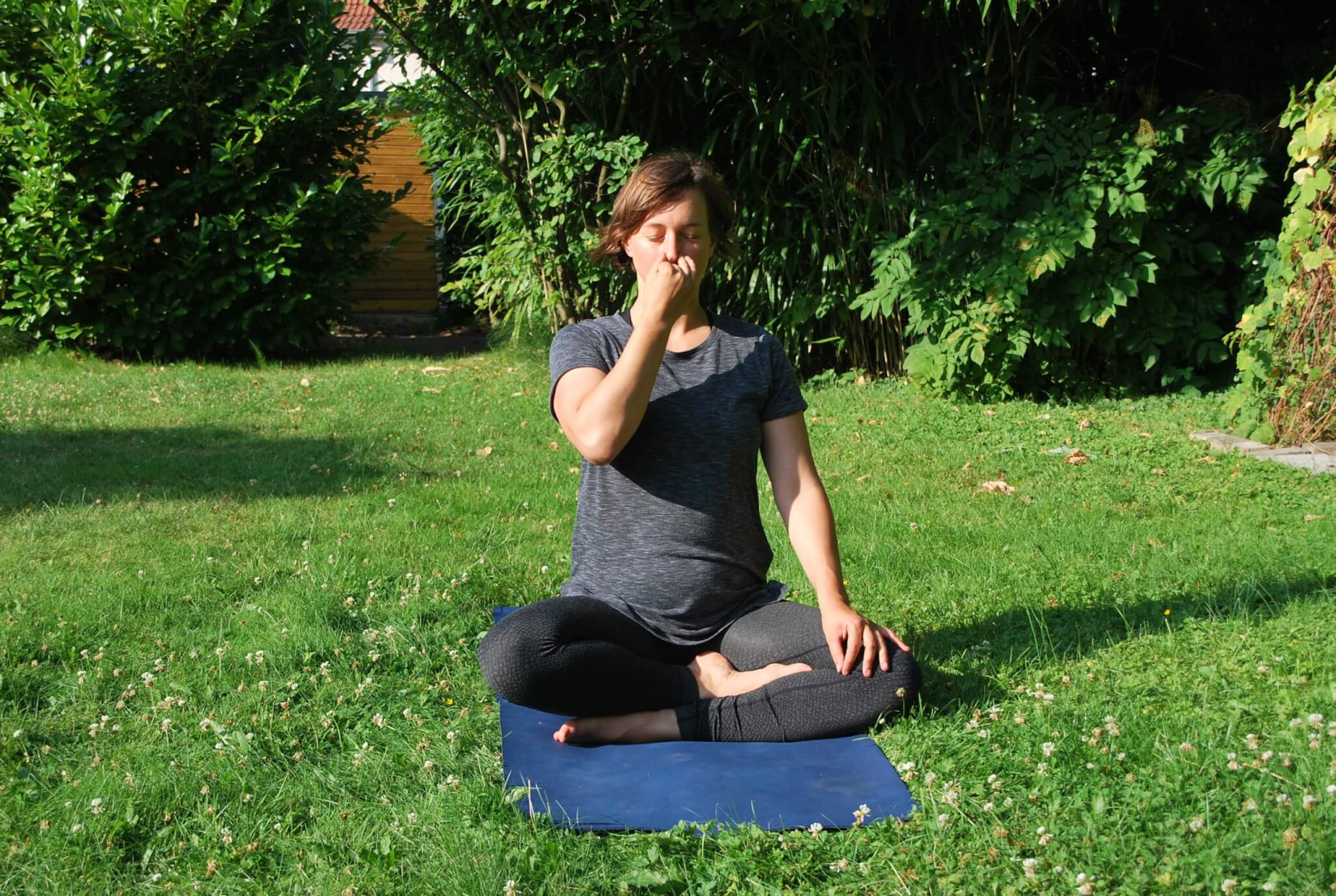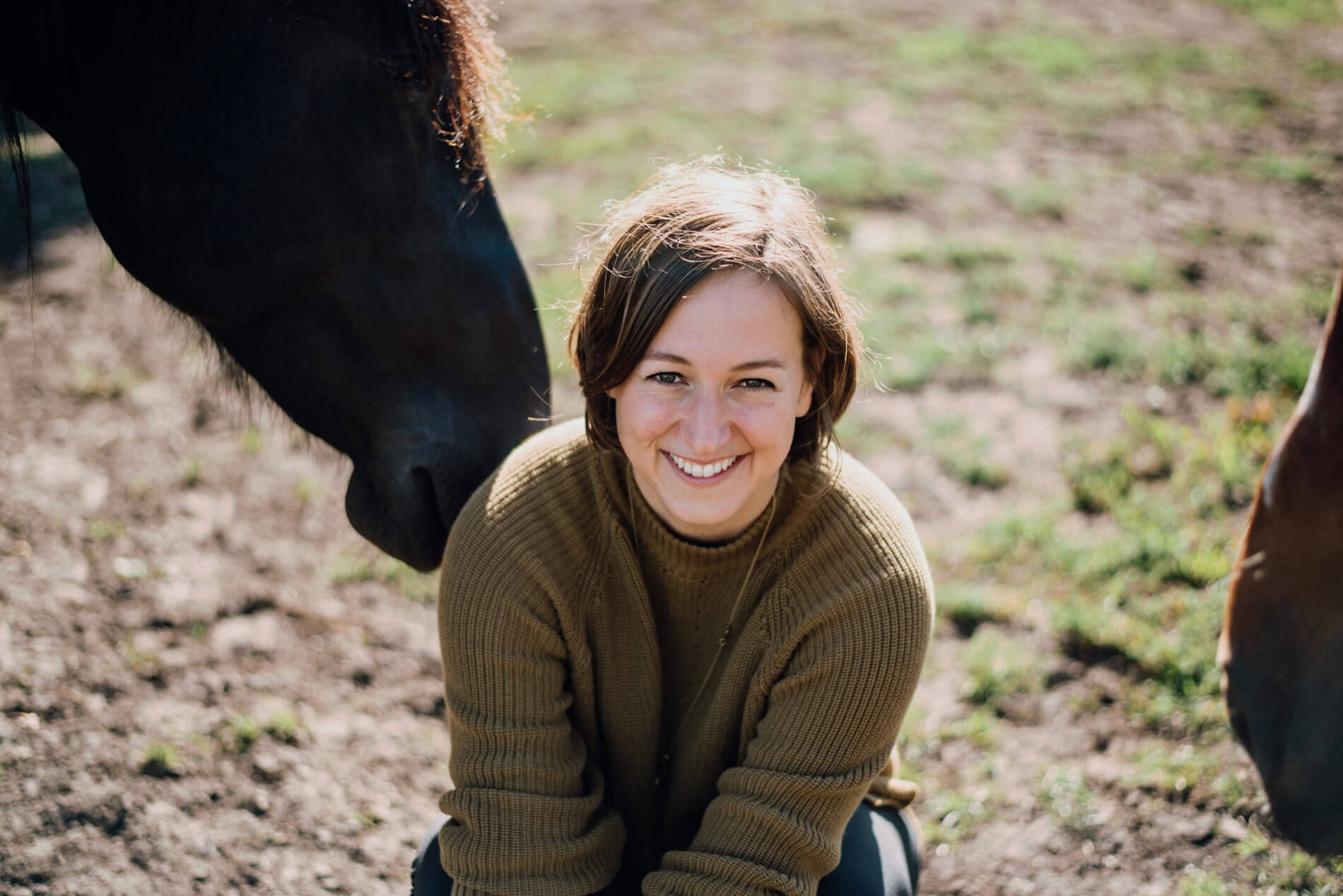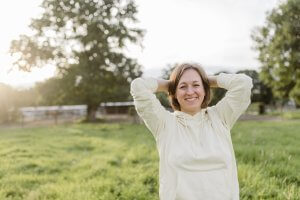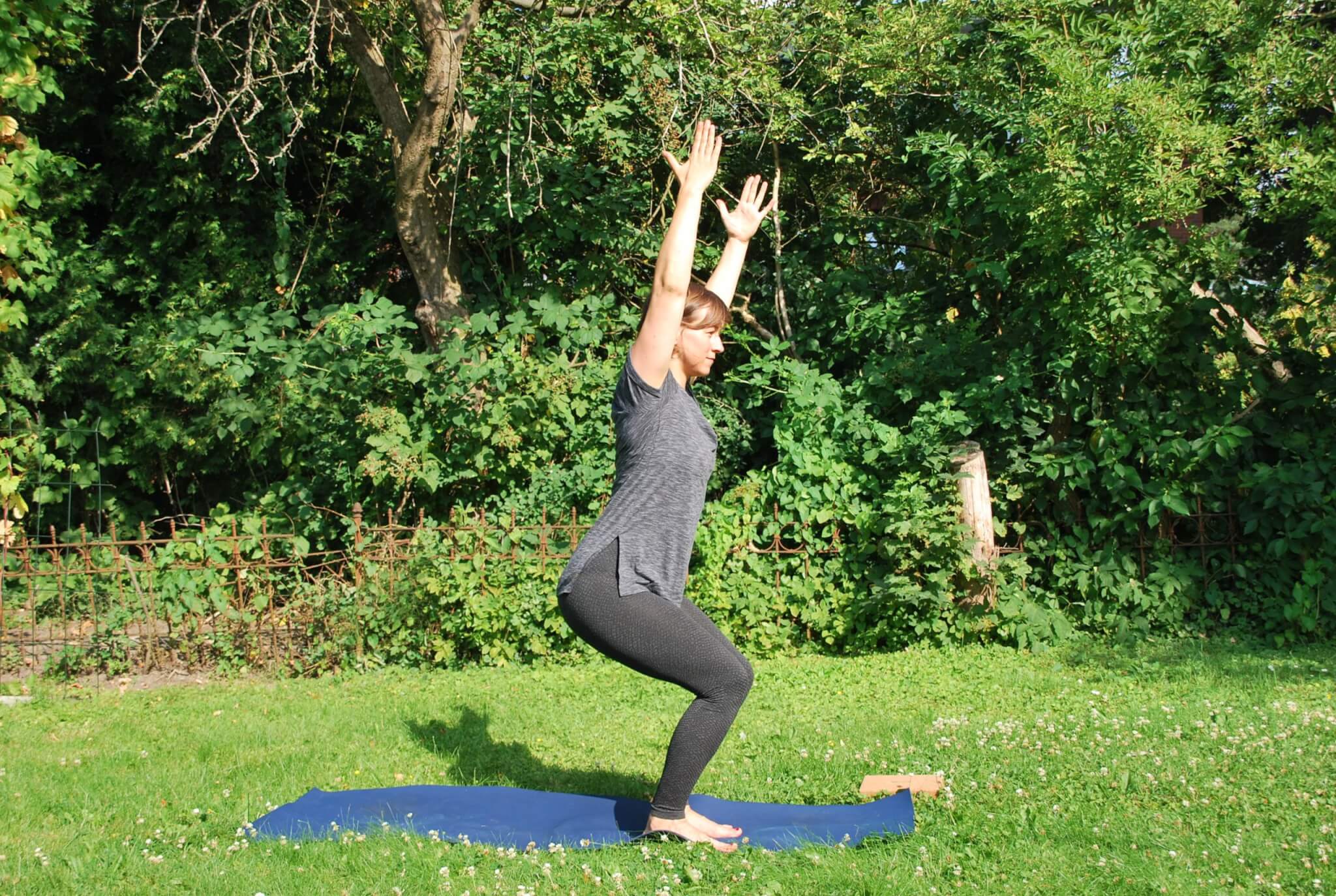
What is this “yoga thing” and how can it work so extensively?
Yoga is good for riders. This rumor has been spreading slowly. But why exactly is that and how does yoga help to ensure a correct, balanced seat in the saddle, maybe even making us better people for our horses overall? Daniela Kämmerer takes a closer look at the topic for us.
Seiteninhalt
Case Studies: How yoga helped riders to become better horse people
Brigitte has ridden all her life. She runs a riding school, she also teaches herself and regularly rides many of her school horses. Many would consider her a very good rider (even though not necessarily she herself). However, when she saw herself on horseback in a video after a long time of “just riding”, she was shocked: “My back is totally rounded, it looks terrible!”
Brigitte also started yoga last year, but for other reasons : To “calm down” – and because of her regular back pain. When she recently saw a riding video of herself again, she was relieved: the rounded shoulders were gone, she was sitting upright, stable and swinging loosely on the horse again, exactly as she would like it for her students.
However, her feeling had changed long before that visual proof: “I can straighten up much better, I am much freer in my chest and often feel like I am glued to the saddle and my horse even on one with a large trot.” Overall, she felt also more open, more relaxed, happier – and, most astonishingly, “hasn’t had a single day of back pain since her first yoga class”. What had happened there …?
Dorothy used to ride advanced dressage exercises with her mare, but for some time now and having had knee surgery, she’d had trouble riding her even along the fence of the arena. Nothing had been going the way it used to. “I had the feeling that she always pulled in on the left, and the more I worked against it, the worse it got. It was so frustrating.” Although she felt that something was off, she didn’t know how to help herself and her horse. With each ride, the frustration and paralyzing feeling of not being in control of her own body grew.
At some point, a stable colleague recommended a yoga class especially for riders. The exercises helped her to recognize which movements were difficult for her, which side is her own weaker side, and she learned to work with individual muscles in a more precise manner. On days when Dorothy felt focussed and balanced enough, she was soon able to ride her mare on a straight line again. In addition to the new body awareness, she has calmed down and she has realized that her body needs professional help to find balance again. A visit to the chiropractor diagnosed a very clear pelvic misalignment, which she is now slowly compensating for with the help of yoga exercises. She now has more fun with her horse weekly, the old lightness returns and with it the relief that the body can get used to strange things, but also can unlearn them again. And she had the exciting realization that she was able to help herself to a large extent.
Katharina is a dedicated, ambitious type of horsewoman and only wants the best for her horse. She trained her gelding herself and both are very well rehearsed. But like every horse-rider pair, these two had come up against limits, too. Katharina had often felt stressed and has had some physical blockages that kept getting in her way. For example, she hadn’t been able to breathe deeply, it felt like something was blocking her. Also, the circles she rode were rounder on one hand than on the other. The gallop they had completely excluded at first because her gelding hadn’t found his balance. And she hadn’t been able to touch him directly on the head for a while, but she had accepted that as a peculiarity of her horse. One day when she heard about a yoga class for riders, she decided to try again. She had attended a yoga class a few years ago, but decided that she was “just too inflexible” and “therefore not suitable for yoga”.
The original six-week course was repeatedly extended and became a permanent appointment for Katharina. She noticed that she was less dominated by the stress that she felt and that she felt more in her body. Between classes, she soon found more and more opportunities to incorporate yoga exercises into her everyday life. Success has been motivating her: Her breathing has become much deeper and her entire body has become more relaxed, calmer. Her circles are now even on both sides, because Katharina has learned to use her right leg as flexibly as her left. And the two are making great progress in the gallop as well. Not because Katharina is ambitiously dedicated to this goal, but because they both enjoy it. And: After a yoga lesson on “mindful touch”, she can now touch her gelding’s head again. She says that yoga has changed the relationship between her and her horse on all kinds of levels.
The riders described above do exist, they only have different names. They have in common that none of them have blamed their horse for the problems, which is great news for them! And that they have all learned to use yoga to change the situation for themselves and their horse for the better.
What is this “yoga thing” and how can it work so extensively?
It is so difficult for us riders to find the quietness in the mind, the presence and the physical relaxation in takes to be as equally soft, agile and strong in the saddle as we want to be. “Being human” all the time is a versatile and demanding task and becoming present and the best possible riders for our horses basically at the push of a button, is not that easy.
On a physical level, the cause of almost all typical problems with the rider’s seat is stiff hips and low body poise. In the opinion of many trainers, the most important skill of a rider is to be able to switch on and off, tense and let go, individual muscles – but also the mind.
And all of that is exactly what we practice in yoga. Yoga is a holistic philosophy that is over 2,000 years old. The physical exercises are just the tip of the iceberg. Rather, yoga wants no less than to connect body, mind and soul.
In yoga we become aware of our patterns and get the chance to create new, more useful ones. Head and body can get used to almost everything we continue to ask for, but can also unlearn it. In the controlled environment of the yoga mat we notice that we are in charge of our inner and outer posture. Little by little we learn to use our thoughts and our bodies more consciously and effectively – in everyday life and also around our horses.
We move and strengthen individual parts of the body, learn to target them and get out of our thinking mind. This quickly creates a better feel for our body – and its limits. Almost anyone who has tried yoga knows: After just a few yoga exercises, we often feel calmer and more centered. And in the long term, we become more agile and vigorous, tend to promote more healthy movement patterns and can apply the experience from yoga classes in everyday life aswell as in connection with our horses.
And that is exactly the “magical” experience that Brigitte, Dorothy and Katharina have had and continue to have. And which helps them to gradually become better and better people for their horses. No matter what was yesterday.
Which yoga exercises are particularly suitable for riders?
Almost every yoga exercise that we practice correctly and in alignment with our physical and emotional state can promote hip mobility, core stability and calmness in the head, and therefore: further develop the riding seat. Of course, the exercises have different focuses.
I recommend doing the following postures as a small series. Everything helps and has a holistic positive effect on the body and mind. Of course, individual exercises can also be used to reach different goals.
We pick the following objectives:
A: Becoming more relaxed
B: Sitting straight in turns (no sinking in the waist, no excessive rotation)
C: Sitting upright and soft (no rounded back, but also no excessive tilting of the pelvis, safe sitting out at a trot)
D: Finding quiet, long legs
Important: Perform each exercise slowly and consciously, in the rhythm of your own breathing. If an exercise causes pain, stop doing it! Yoga can be exhausting, but it should never hurt. If in doubt, ask your doctor before trying any exercise. And: If you need a break, take it. Always.
1. Seated breathing exercise
Aim: deepening of breathing, straightening of the spine and pelvis (A, C, D)
Find a comfortable seat. Allow your pelvis to find a neutral position. Sitting on a book, a folded blanket, etc. can help here.
Relax your shoulders, take your time to arrive.
Then imagine three balloons in your torso: one in your lower abdomen, one in your upper abdomen and one in your chest. Imagine their color and exact size. Inhale and first fill the lower balloon, then the middle, then the upper balloon with air. Exhale and empty the lower balloon first, then the middle and finally the upper balloon. Take 5-7 deep breaths like this and observe how the upper body widens in all directions. Let go of the picture and feel it.
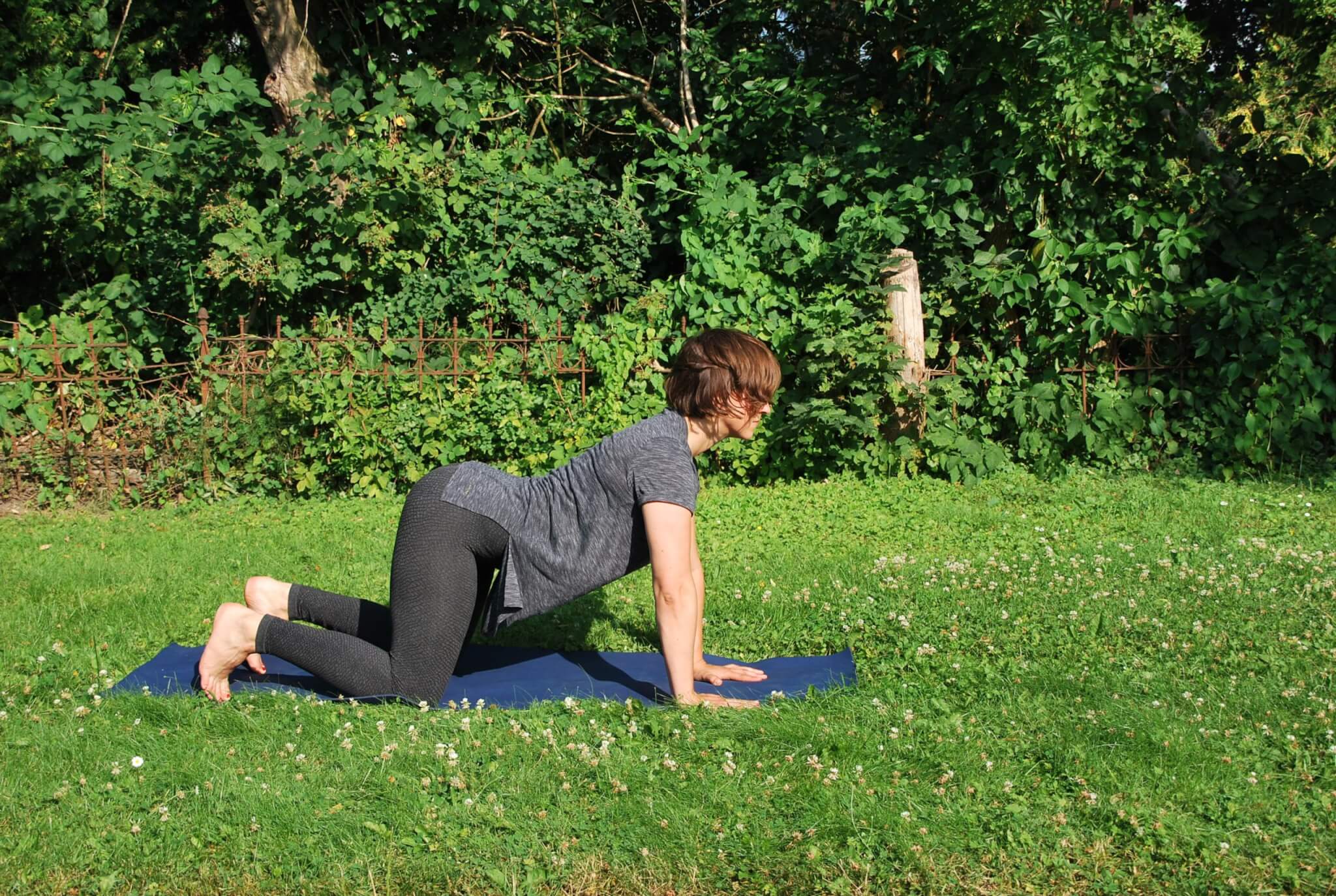
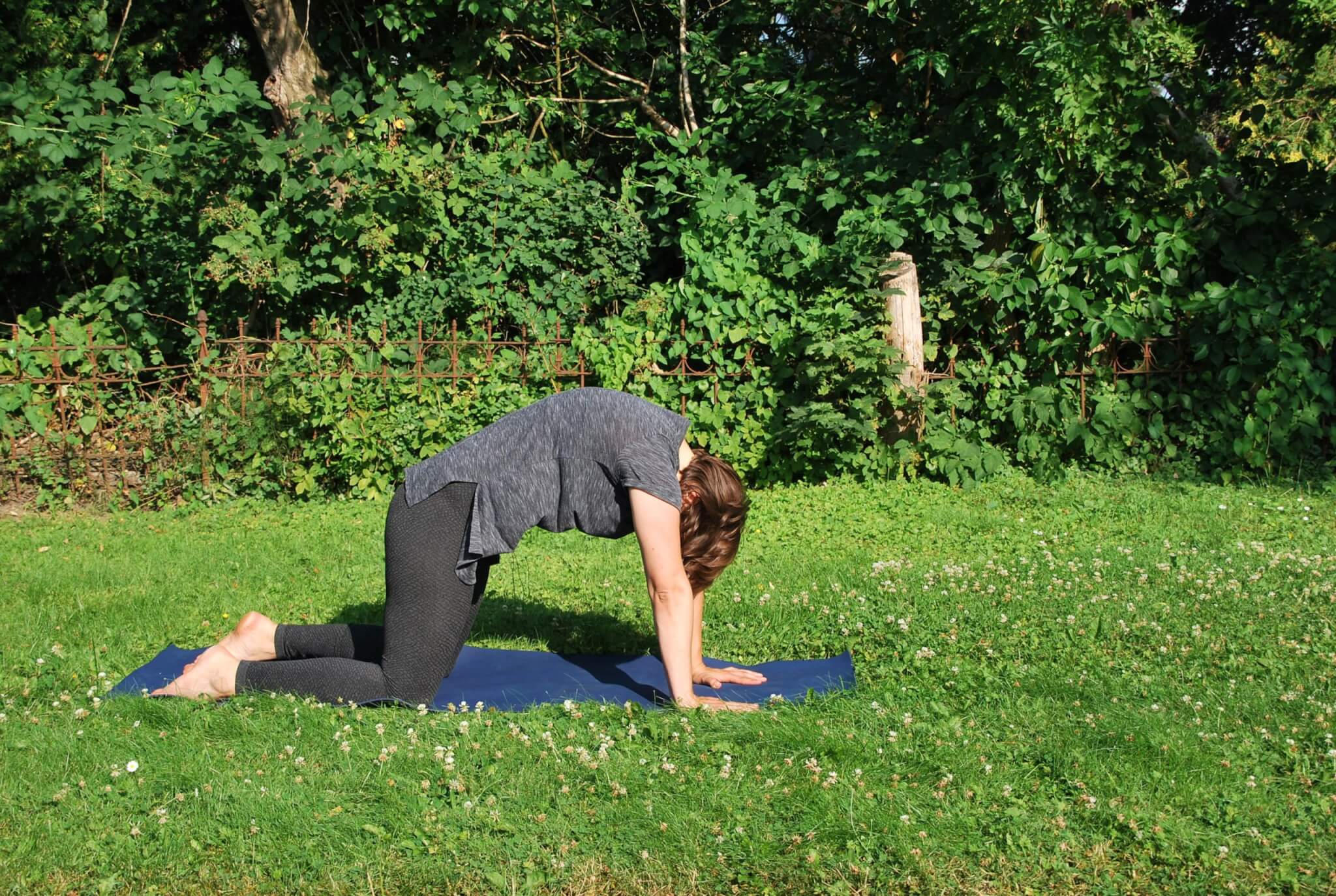
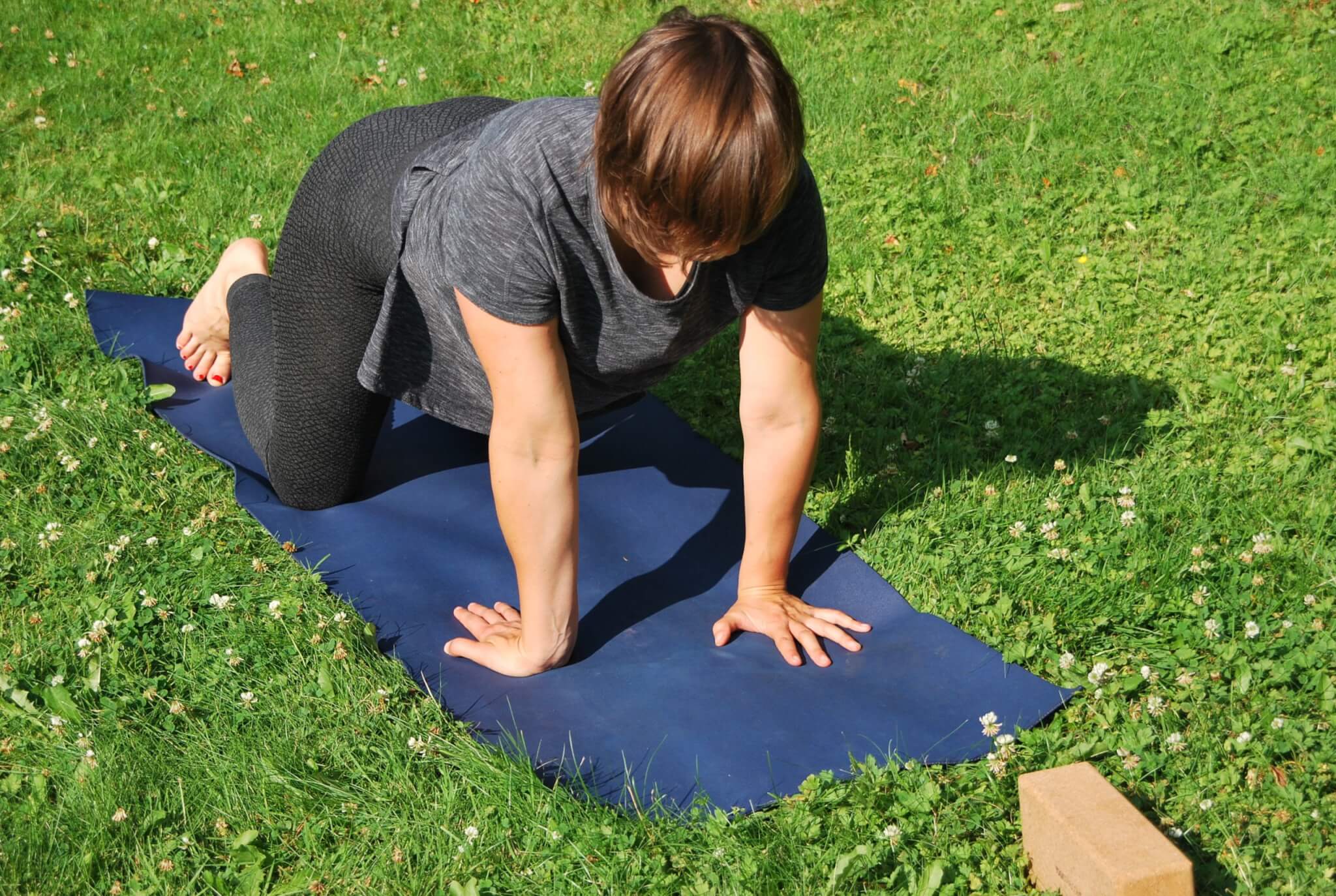

x2. Cat-cow movement
Aim: Mobilizing the spine, promoting the connection of breath and movement (A)
Come to all fours. Inhale and hollow your back. To do this, tilt the pelvis forward, the head follows along. Exhale and tilt the pelvis backwards (up), pull the navel upwards towards the spine and round the entire back, like a scared cat. Start every movement with the conscious movement of the pelvis. Repeat a few times in the natural breathing rhythm.
2a. Variant for more strength and length
Aim: promoting length in the body, strength in the middle of the body, mobility of the spine (B, C, D)
On all fours, raise your left hand, stretch your arm forward. If you can, also raise your right leg, stretch your leg and flex your toes like you are pressing the foot on a wall behind you. Inhale a little more, and then exhale and lead your knees and elbows under your body to meet and round your back. Repeat, getting a little longer with each inhalation and with each exhalation pulling the belly button upwards towards the spine. Feel the movement of your pelvis. Change of sides.
2b. Variant for “softer” hands
Aim: stretching and stimulating the wrists, promoting communication via the reins, opening the shoulders (A, C)
On all fours, carefully turn your right hand outwards and all the way back, so that your wrist crease is parallel to the front of your mat (if you have one). Take small, then larger circles around your wrist with your upper body. Switch sides. Then repeat the exercise with both wrists. At the end keep both wrists twisted and buttocks towards your heels as far as you can. Stay here and breathe.
2c. Variant for the hips
Aim: More flexibility in the hip joints, stretching the lateral abdominal muscles (B, C, D)
On all fours, inhale and lift your right knee up to the side, like a peeing dog. Exhale and lower it, hovering briefly over the floor. Inhale again and lift your leg. At least 7-10 repetitions, then switch sides.
3. Crescent Pose
Aim: stretching and strengthening the hip flexors and anterior thigh muscles, the abdominal muscles and the back, opening the shoulders (B, C, D)
Take a deep lunge, your right foot is in front. Lower your left knee to the floor, put your fingertips on the floor, lengthen your torso. Press your feet down in the floor, so that you can lift your hands up and stretch the arms towards the sky. Turn your pinky fingers towards each other. Inhale and mentally pull the inner foot and the back knee together, so that your pelvis lifts up a little higher. Exhale and sink deeper into the front knee and lean back a little more if possible. Repeat these movements a few times following the rhythm of your breath, then stay low. The pelvis points forward, the inside of the left thigh wants topulls up. Find the point between too much and not enough stretch. Get out of the posture, go through the cat-cow movement (see above) and change sides.
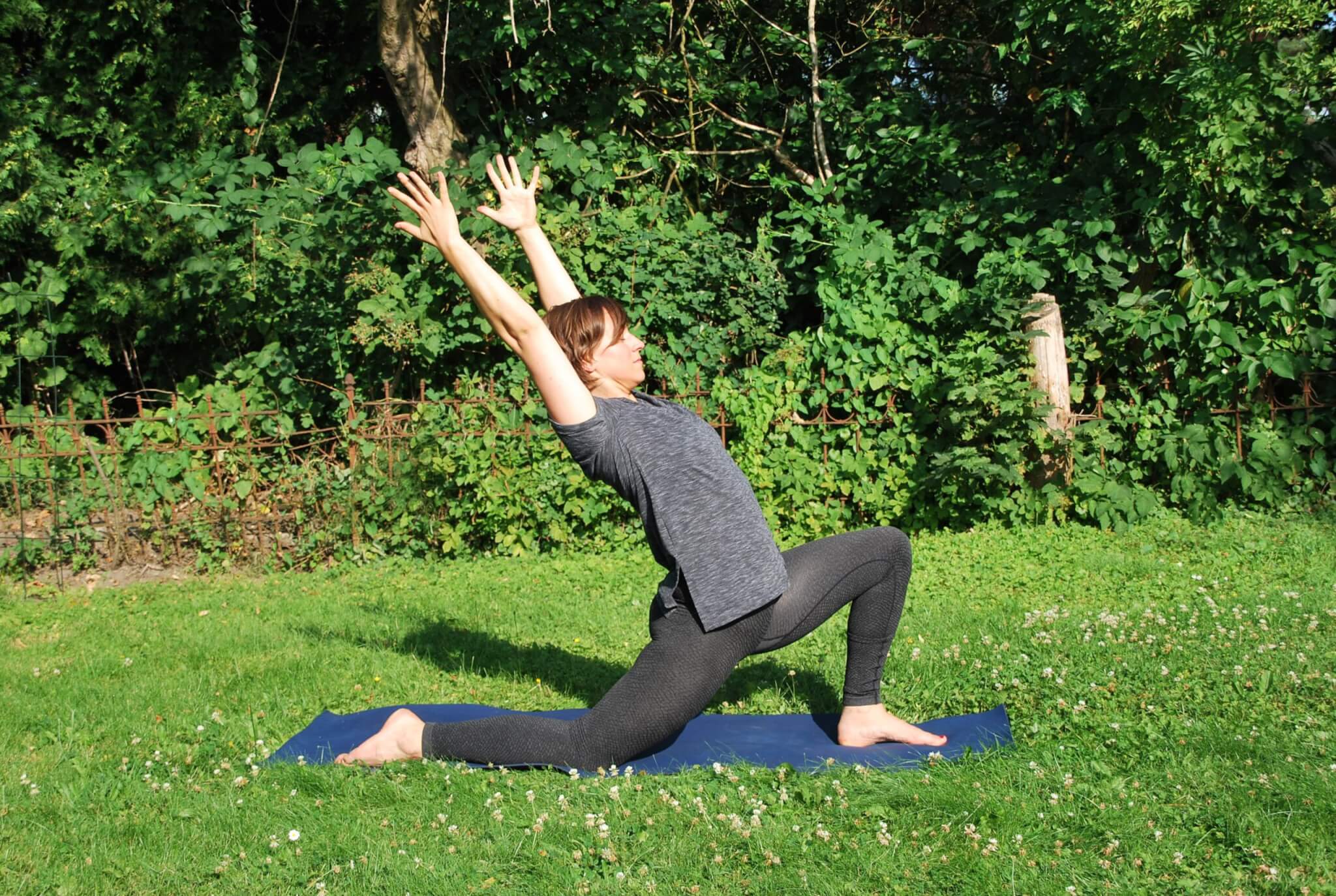
4. Chair Pose
Aim: Strengthening the entire middle of the body, all leg muscles and joints, opening the shoulder joints, “power pose” (A, B, C, D)
Stand upright, feet hip-width apart. Extend your arms forward. Have your palms face each other, your shoulders remain relaxed and in. Bend your knees now and move your pelvis back as if you were sitting down on a chair. Breathe calmly and evenly, stay as relaxed as possible. Keep your body strong and softly pull the navel towards the spine with each exhale. Make sure your heels are on the floor, and your back is almost straight. For extra strength, make fists with your hands. If possible, pull your arms over your head. After a few breaths, push into your feet and straighten up with a flat back.

5. Wide-legged forward fold
Aim: stretching the back of the legs / inside / outside, straightening the upper body, calming the nervous system (A, C, D)
Take a wide stance. Put your hands on your hips, and have your elbows pull back slightly. Keep your back straight. Bend your knees slightly, exhale and lean forward. Let go of the head and neck, hands on the ground. Find a comfortable stretch in the thighs by bending the knees as much as it takes for you to feel good here.
5a. Variation with rotation
Aim: Stabilization of the pelvis, stretching the sides of the body, opening the shoulder (B, C, D)
From the wide-legged forward fold, but your left hand under your face, straighten your back. Extend your right arm up. Keep pelvis straight and distribute weight on both legs, bend one or both if necessary. Change of sides after a few breaths.



6. Side plank variation
Aim: stretching and strengthening the lateral abdominal muscles, strengthening the shoulder (B, C)
Lie on the side. With one elbow placed under your shoulder, press your forearm down into the floor. Bend your knees. Inhale, move your top arm forward and over your head. Exhale and move your arm back to your side, lowering the pelvis slightly. Inhale and lift your arm, move it forward and over your head, lifting your pelvis, exhale and lower back down, etc. The bottom shoulder remains active and shouldn’t collapse. 7-10 repetitions, then switch sides.
For a greater challenge: Stretch your legs, now lift your knees off the mat, place the outer edge of your feet on the floor and repeat the exercise.
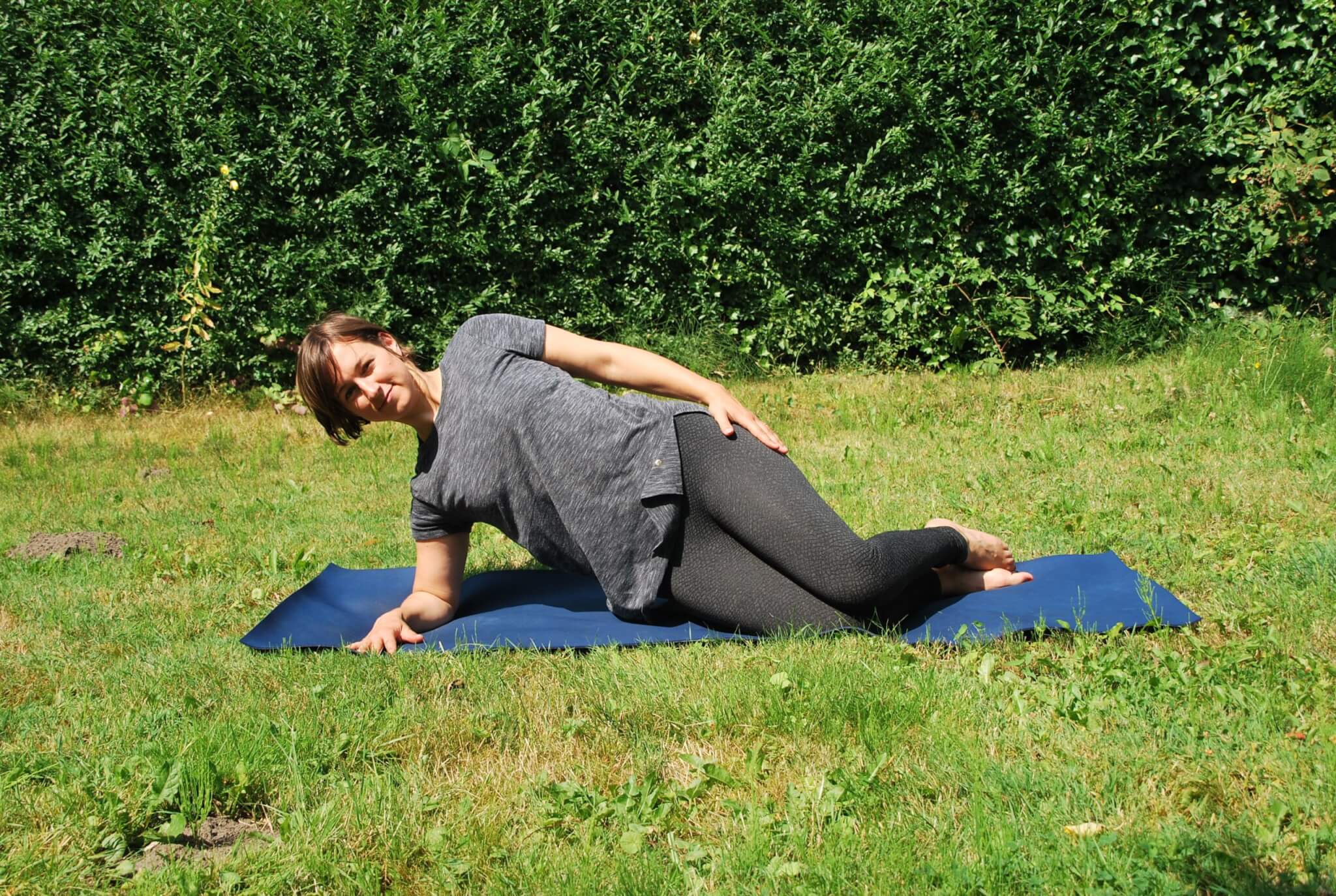
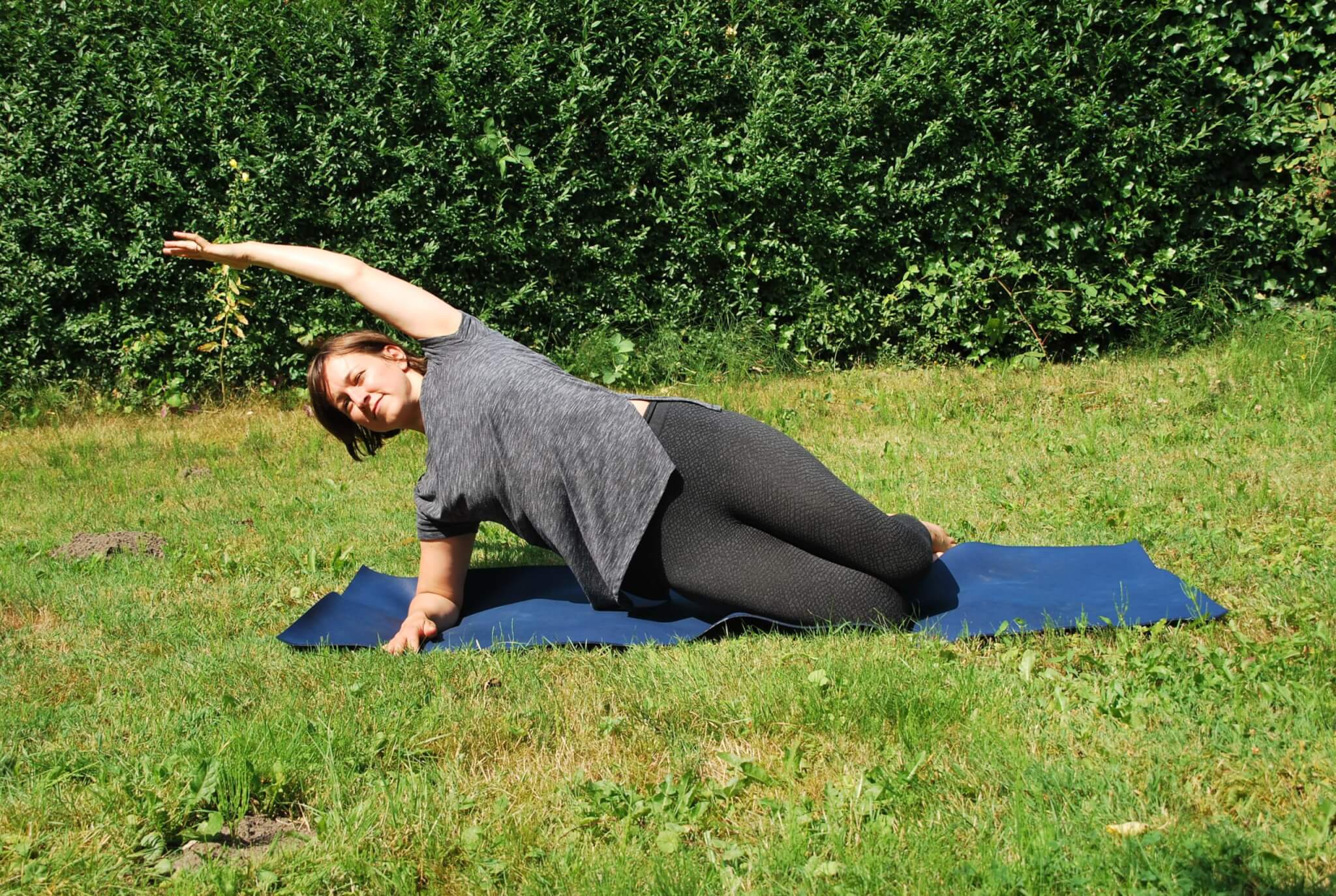
7. Locust pose with arm variation
Aim: Strengthening the back and shoulders, stretching the shoulders, hip flexors and front thighs (C, D)
Lie on your belly. Put your arms in a “cactus position”: shoulders and elbows lined up, elbows bent, forearms pointing forward. Inhale and lift your head, sternum and arms, turn your thumbs up. Hold here and then exhale, stretch your arms forward. Inhale and pull shoulder blades towards each other. Exhale and stretch. Repeat a few times. Then lower your upper body down, put your hands under your forehead and wiggle your pelvis to remove any tension. Two more times. If your lower back is okay, raise your legs as well. Lie down and relax briefly after each run.
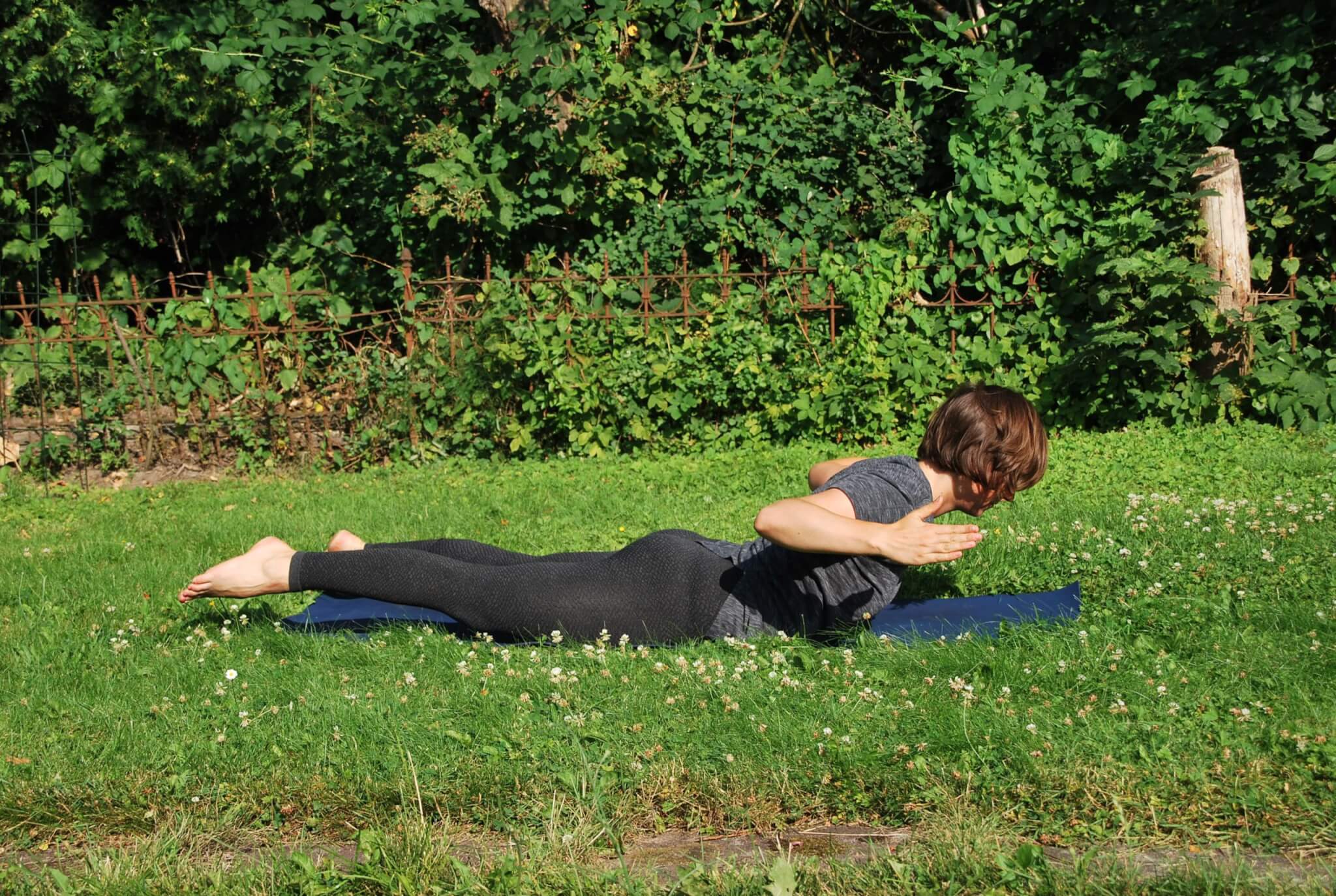
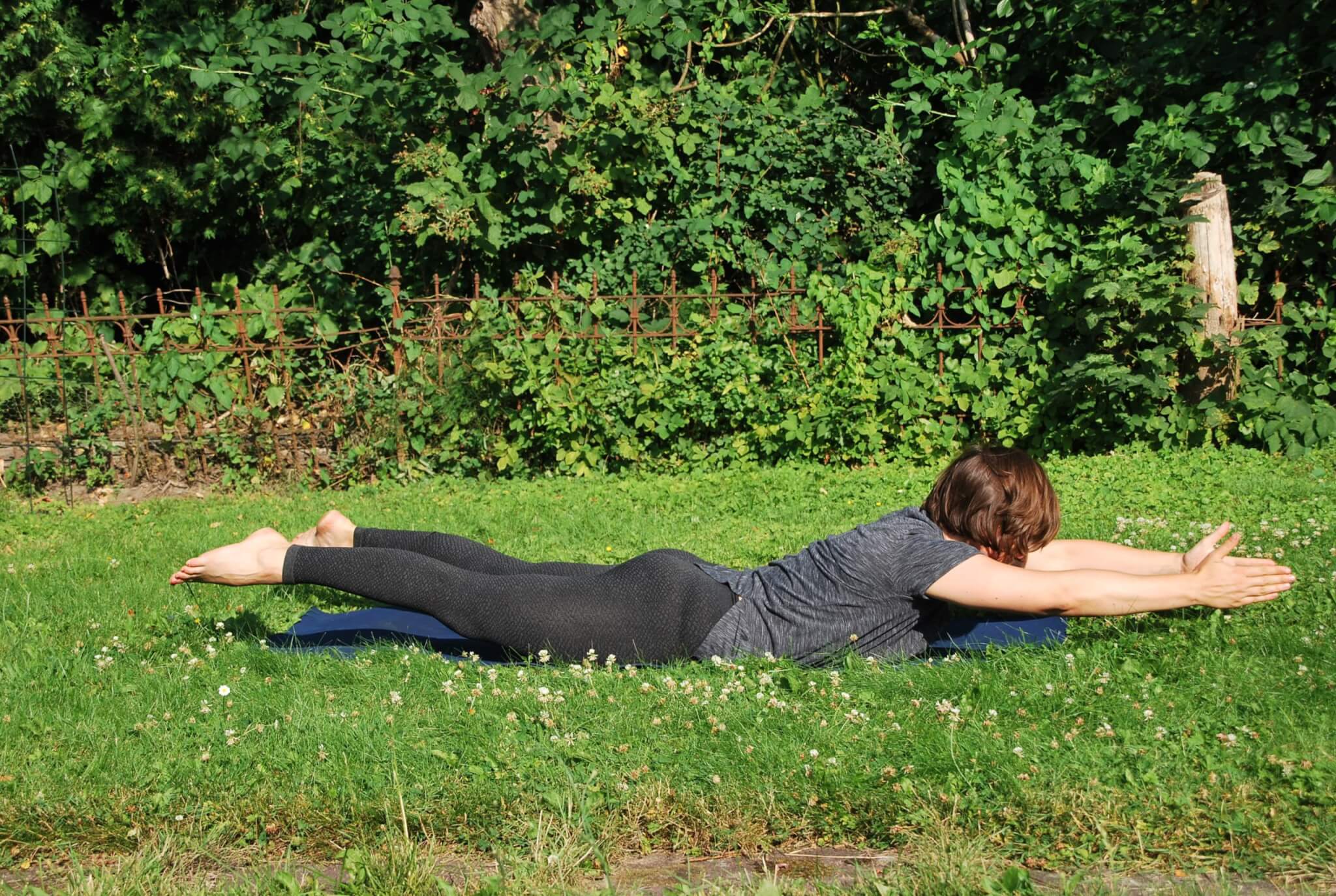
8. Piriformis Stretch
Aim: More mobility in the pelvis, loosening solid structures, also psychologically (A, C, D)
Lie on your back. Rest your feet just behind your butt. The spine is in its natural shape, the lower back lifting slightly off the floor (if necessary, tilt the pelvis gently forward). Place your right ankle over your left thigh, flex your feet. Here you should feel a stretch around the right side of your pelvis. If necessary, gently push the right thigh away with your hand. Hold and breathe (for at least 30 seconds). Emphasize the exhalation and extend it conciously. Change sides. At the end pull both knees toward you and swing gently back and forth on your back a few times.
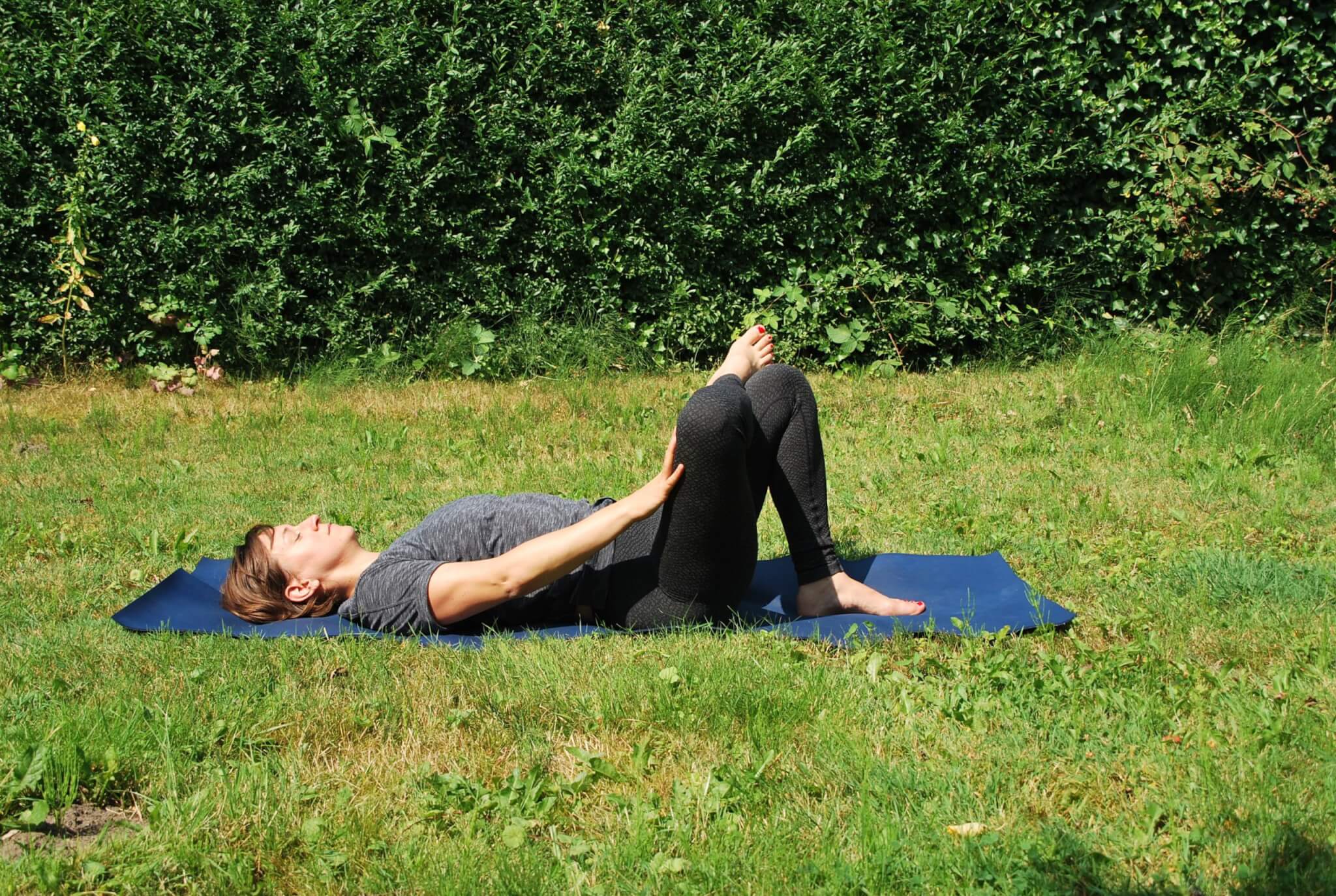
9. Alternate nostril breathing
Aim: deepening of breathing (immediate calming of the nervous system, reduction of stress), balancing the left and right hemispheres of the brain and body (A, B, C, D)
Find an upright, comfortable seat (see above). Raise your right hand, folding your index and middle finger in. Move your right hand to your nose, the left one gets to rest on your thigh or wherever it feels right. Place your thumb on the right nostril and your ring finger on the left. Exhale, close with the ring finger on the left and inhale on the right. Close with both fingers, hold your breath briefly, then open on the left and exhale, keep closed on the right.
Breathe in on the left, close. Hold your breath. Exhale through the right nostril. Inhale through the right side, close, hold. Exhale through the left, etc. Repeat for a few minutes while breathing. End with an exhalation through the right nostril. Feel the change for a moment before moving back into your day.
